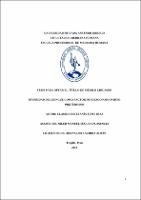Severidad del dengue como factor de riesgo para parto pretérmino

Ver/
Descargar
(application/pdf: 175.0Kb)
(application/pdf: 175.0Kb)
Fecha
2018Autor(es)
Tume Diaz, Claudia Estefanía
Metadatos
Mostrar el registro completo del ítemResumen
Objetivo: Evaluar si la severidad del dengue es un factor de riesgo para el desarrollo de parto
pretérmino en el Hospital José Cayetano Heredia III Piura en el periodo 2016-2017.
Material y Métodos: Se llevó a cabo un estudio de cohorte retrospectivo donde se evaluó 184
gestantes con dengue, 70 tuvieron dengue con signos de alarma
( DCSA ) y 114 dengue sin signos de alarma ( DSSA ) . Se verificó en la historia clínica el desarrollo de parto pretérmino
durante la gestación.
Resultados: Se encontró que el 46% de gestantes con DCSA desarrolló parto pretérmino ( PPT ) ( RR1.70, IC 95% 1.28-2.227 p<0.05)
y 39% de gestantes con DSSA desarrollaron esta
complicación. Además se analizaron otras variables intervinientes como edad, trimestre de infección, paridad, nivel de instrucción, estado civil y obesidad. Solo resultó esadisticamente significativa la obesidad ( RR 0.58 IC95%, 0.39-0.85, p>0.05) . En el análisis multivariado se confirmó la severidad del dengue ( DCSA ) como un factor de riesgo y la obesidad como un factor protector. En la regresión logística hallamos que el presentar DCSA y no ser obesa
incrementó 3.29 veces la posibilidad de desarrollar PPT; sin embargo, al incluir la variable
obesidad se produjo una disminución al 50.6% de riesgo en relación a si no presentará dicha
condición.
Conclusiones: La severidad del dengue si fue un factor para el desarrollo de PPT en gestantes. Objective: To evaluate if the severity of dengue is a risk factor for the development of preterm
birth in the Jose Cayetano Heredia III Piura Hospital in the period 2016-2017.
Material and Methods: A retrospective cohort study was conducted where 184 pregnant
women with dengue were evaluated, 70 had dengue with warning signs
( DCSA ) and 114 dengue without warning signs ( DSSA ) . The development of preterm partitioning during pregnancy was verified in the clinical history. Results: It was found that 46% of pregnant women with DCSA had preterm birth ( RR1.70, 95% CI 1.28-2.227 p <0.05) and 39% of pregnant women with DSSA developed this
complication. In addition, other intervening variables were analyzed, such as age, infection
trimester, parity, level of education, marital status and obesity. Obesity was only found to be statistically significant ( RR 0.58 IC95%, 0.39-0.85, p> 0.05) . In the multivariate analysis, the severity of dengue ( DCSA ) is confirmed as a risk factor and obesity as a protective factor. In
the logistic regression we found that having DCSA and not being obese increased 3.29 times
the possibility of developing PPT; however, including the obesity variable was a 50.6%
decrease in risk in relation to if it did not present that condition.
Conclusions: The severity of dengue is a factor for the development of PPT in pregnant
women.
Palabras clave
Colecciones
- Medicina Humana [3196]

